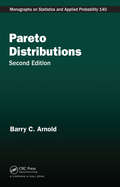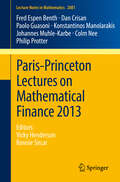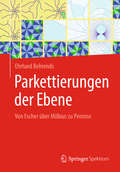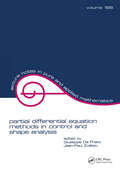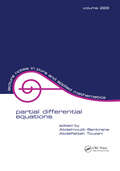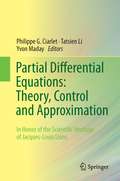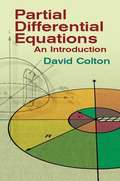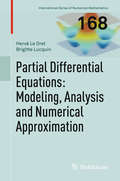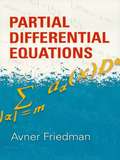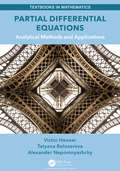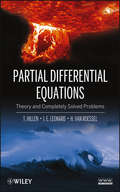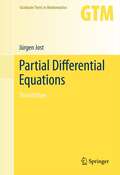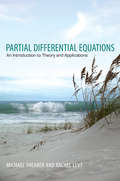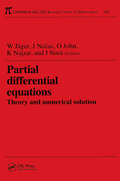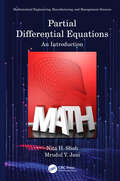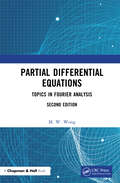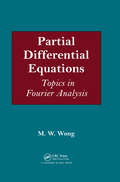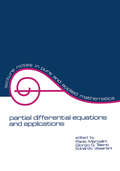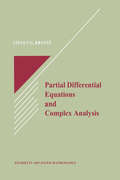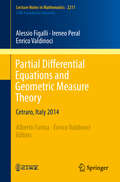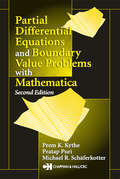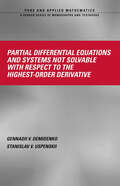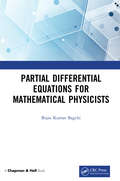- Table View
- List View
Parents Without Papers: The Progress and Pitfalls of Mexican American Integration
by Frank D. Bean James D. Bachmeier Susan K. BrownFor several decades, Mexican immigrants in the United States have outnumbered those from any other country. Though the economy increasingly needs their labor, many remain unauthorized. In Parents Without Papers, immigration scholars Frank D. Bean, Susan K. Brown, and James D. Bachmeier document the extent to which the outsider status of these newcomers inflicts multiple hardships on their children and grandchildren. Parents Without Papers provides both a general conceptualization of immigrant integration and an in-depth examination of the Mexican American case. The authors draw upon unique retrospective data to shed light on three generations of integration. They show in particular that the “membership exclusion” experienced by unauthorized Mexican immigrants—that is, their fear of deportation, lack of civil rights, and poor access to good jobs—hinders the education of their children, even those who are U.S.-born. Moreover, they find that children are hampered not by the unauthorized entry of parents itself but rather by the long-term inability of parents, especially mothers, to acquire green cards. When unauthorized parents attain legal status, the disadvantages of the second generation begin to disappear. These second-generation men and women achieve schooling on par with those whose parents come legally. By the third generation, socioeconomic levels for women equal or surpass those of native white women. But men reach parity only through greater labor-force participation and longer working hours, results consistent with the idea that their integration is delayed by working-class imperatives to support their families rather than attend college. An innovative analysis of the transmission of advantage and disadvantage among Mexican Americans, Parents Without Papers presents a powerful case for immigration policy reforms that provide not only realistic levels of legal less-skilled migration but also attainable pathways to legalization. Such measures, combined with affordable access to college, are more important than ever for the integration of vulnerable Mexican immigrants and their descendants.
Pareto Distributions (Chapman & Hall/CRC Monographs on Statistics and Applied Probability)
by Barry C. ArnoldSince the publication of the first edition over 30 years ago, the literature related to Pareto distributions has flourished to encompass computer-based inference methods. Pareto Distributions, Second Edition provides broad, up-to-date coverage of the Pareto model and its extensions. This edition expands several chapters to accommodate recent result
Paris-Princeton Lectures on Mathematical Finance 2013
by Ronnie Sircar Paolo Guasoni Vicky Henderson Fred Espen Benth Philip Protter Konstantinos Manolarakis Colm Nee Johannes Muhle-Karbe Dan CrisanThe current volume presents four chapters touching on some of the most important and modern areas of research in Mathematical Finance: asset price bubbles (by Philip Protter); energy markets (by Fred Espen Benth); investment under transaction costs (by Paolo Guasoni and Johannes Muhle-Karbe); and numerical methods for solving stochastic equations (by Dan Crisan, K. Manolarakis and C. Nee).The Paris-Princeton Lecture Notes on Mathematical Finance, of which this is the fifth volume, publish cutting-edge research in self-contained, expository articles from renowned specialists. The aim is to produce a series of articles that can serve as an introductory reference source for research in the field.
Parkettierungen der Ebene: Von Escher Über Möbius Zu Penrose
by Ehrhard BehrendsZiel des Buches ist das Studium von Symmetrien und Parkettierungen, die Künstler und Mathematiker schon seit langer Zeit interessieren. Berühmte Beispiele sind die von den Arabern in der Alhambra geschaffenen Werke und die Bilder des holländischen Malers Maurits Escher. Die Mathematiker haben sich erst im 19. Jahrhundert des Themas intensiv angenommen. Dabei führt die Visualisierung der mathematischen Zusammenhänge zu sehr ansprechenden Bildern. Drei Ansätze werden in diesem Buch beschrieben. In Teil I wird dargestellt, dass es 17 prinzipiell verschiedene Möglichkeiten von Parkettierungen der Ebene gibt, die so genannten "Ebenen Kristallgruppen". Ergänzend dazu werden Ideen von Harald Heesch beschrieben, der zeigte, wie diese theoretischen Ergebnisse praktisch umgesetzt werden können: Er gab einen Katalog von 28 Verfahren an, die man selbst - sozusagen auf den Spuren von Escher - kreativ zur Schaffung künstlerisch anspruchsvoller Parkettierungen verwenden kann. Bei den entsprechenden Untersuchungen für die komplexe Ebene in Teil II werden Bewegungen durch bijektive holomorphe Abbildungen ersetzt. Das führt in die Theorie der Gruppen von Möbiustransformationen: Kleinsche Gruppen, Schottkygruppen usw. Dort gibt es auch interessante Verbindungen zur hyperbolischen Geometrie. Schließlich wird in Teil III noch ein dritter Aspekt des Themas behandelt, die Penroseparkettierungen. Dabei geht es um Ergebnisse aus den siebziger Jahren, als erstmals einfach zu beschreibende und beweisbar nichtperiodische Parkettierungen der Ebene angegeben wurden.
Partial Differential Equation Methods for Image Inpainting
by Carola-Bibiane SchönliebThis book is concerned with digital image processing techniques that use partial differential equations (PDE) for the task of image 'inpainting,' an artistic term for virtual image restoration or interpolation, whereby missing or occluded parts in images are completed based on information provided by intact parts. Computer graphic designers, artists and photographers have long used manual inpainting to restore damaged paintings or manipulate photographs. Today, mathematicians apply powerful methods based on PDE to automate this task. This book introduces the mathematical concept of PDE for virtual image restoration. It gives the full picture, from the first modelling steps originating in Gestalt theory and arts restoration to the analysis of resulting PDE models, numerical realisation and real world application. This broad approach also gives insight into functional analysis, variational calculus, optimisation and numerical analysis and will appeal to researchers and graduate students in mathematics with an interest in image processing and mathematical analysis.
partial differential equation methods in control and shape analysis: lecture notes in pure and applied mathematics (Lecture Notes in Pure and Applied Mathematics)
by Giuseppe Da Prato Jean-Paul Zolésio"Based on the International Federatiojn for Information Processing WG 7.2 Conference, held recently in Pisa, Italy. Provides recent results as well as entirely new material on control theory and shape analysis. Written by leading authorities from various desciplines."
Partial Differential Equations (Lecture Notes in Pure and Applied Mathematics)
by Abdelmoujib Benkirane Abdelfattah TouzaniThis impressive compilation of the material presented at the International Conference on Partial Differential Equations held in Fez, Morocco, represents an integrated discussion of all major topics in the area of partial differential equations--highlighting recent progress and new trends for real-world applications.
Partial Differential Equations: Theory, Control and Approximation
by Philippe G. Ciarlet Tatsien Li Yvon MadayThis book collects papers mainly presented at the "International Conference on Partial Differential Equations: Theory, Control and Approximation" (May 28 to June 1, 2012 in Shanghai) in honor of the scientific legacy of the exceptional mathematician Jacques-Louis Lions. The contributors are leading experts from all over the world, including members of the Academies of Sciences in France, the USA and China etc. , and their papers cover key fields of research, e. g. partial differential equations, control theory and numerical analysis, that Jacques-Louis Lions created or contributed so much to establishing.
Partial Differential Equations: An Introduction (Dover Books on Mathematics #No. 42)
by David ColtonIntended for a college senior or first-year graduate-level course in partial differential equations, this text offers students in mathematics, engineering, and the applied sciences a solid foundation for advanced studies in mathematics. Classical topics presented in a modern context include coverage of integral equations and basic scattering theory. This complete and accessible treatment includes a variety of examples of inverse problems arising from improperly posed applications. Exercises at the ends of chapters, many with answers, offer a clear progression in developing an understanding of this essential area of mathematics. 1988 edition.
Partial Differential Equations: Modeling, Analysis and Numerical Approximation
by Hervé Le Dret Brigitte LucquinThis book is devoted to the study ofpartial differential equation problems both from the theoretical and numericalpoints of view. After presenting modeling aspects, it develops the theoretical analysis of partialdifferential equation problems for the three main classes of partialdifferential equations:elliptic, parabolic and hyperbolic. Several numerical approximation methodsadapted to each of these examples are analyzed: finite difference, finite elementand finite volumes methods, andthey are illustrated using numerical simulation results. Although parts of the book are accessible toBachelor students in mathematics or engineering, it is primarily aimed at Masters students in applied mathematics orcomputational engineering. The emphasis is on mathematical detail and rigor forthe analysis of both continuous and discrete problems.
Partial Differential Equations
by Prof. Avner FriedmanThis three-part treatment of partial differential equations focuses on elliptic and evolution equations. Largely self-contained, it concludes with a series of independent topics directly related to the methods and results of the preceding sections that helps introduce readers to advanced topics for further study. Geared toward graduate and postgraduate students of mathematics, this volume also constitutes a valuable reference for mathematicians and mathematical theorists.Starting with the theory of elliptic equations and the solution of the Dirichlet problem, the text develops the theory of weak derivatives, proves various inequalities and imbedding problems, and derives smoothness theorems. Part Two concerns evolution equations in Banach space and develops the theory of semigroups. It solves the initial-boundary value problem for parabolic equations and covers backward uniqueness, asymptotic behavior, and lower bounds at infinity. The final section includes independent topics directly related to the methods and results of the previous material, including the analyticity of solutions of elliptic and parabolic equations, asymptotic behavior of solutions of elliptic equations near infinity, and problems in the theory of control in Banach space.
Partial Differential Equations: Analytical Methods and Applications (Textbooks in Mathematics)
by Victor Henner Tatyana Belozerova Alexander NepomnyashchyPartial Differential Equations: Analytical Methods and Applications covers all the basic topics of a Partial Differential Equations (PDE) course for undergraduate students or a beginners’ course for graduate students. It provides qualitative physical explanation of mathematical results while maintaining the expected level of it rigor. This text introduces and promotes practice of necessary problem-solving skills. The presentation is concise and friendly to the reader. The "teaching-by-examples" approach provides numerous carefully chosen examples that guide step-by-step learning of concepts and techniques. Fourier series, Sturm-Liouville problem, Fourier transform, and Laplace transform are included. The book’s level of presentation and structure is well suited for use in engineering, physics and applied mathematics courses. Highlights: Offers a complete first course on PDEs The text’s flexible structure promotes varied syllabi for courses Written with a teach-by-example approach which offers numerous examples and applications Includes additional topics such as the Sturm-Liouville problem, Fourier and Laplace transforms, and special functions The text’s graphical material makes excellent use of modern software packages Features numerous examples and applications which are suitable for readers studying the subject remotely or independently
Partial Differential Equations
by T. Hillen I. E. Leonard H. Van RoesselUniquely provides fully solved problems for linear partial differential equations and boundary value problems Partial Differential Equations: Theory and Completely Solved Problems utilizes real-world physical models alongside essential theoretical concepts. With extensive examples, the book guides readers through the use of Partial Differential Equations (PDEs) for successfully solving and modeling phenomena in engineering, biology, and the applied sciences. The book focuses exclusively on linear PDEs and how they can be solved using the separation of variables technique. The authors begin by describing functions and their partial derivatives while also defining the concepts of elliptic, parabolic, and hyperbolic PDEs. Following an introduction to basic theory, subsequent chapters explore key topics including: * Classification of second-order linear PDEs * Derivation of heat, wave, and Laplace's equations * Fourier series * Separation of variables * Sturm-Liouville theory * Fourier transforms Each chapter concludes with summaries that outline key concepts. Readers are provided the opportunity to test their comprehension of the presented material through numerous problems, ranked by their level of complexity, and a related website features supplemental data and resources. Extensively class-tested to ensure an accessible presentation, Partial Differential Equations is an excellent book for engineering, mathematics, and applied science courses on the topic at the upper-undergraduate and graduate levels.
Partial Differential Equations
by Jürgen JostThis book offers an ideal graduate-level introduction to the theory of partial differential equations. The first part of the book describes the basic mathematical problems and structures associated with elliptic, parabolic, and hyperbolic partial differential equations, and explores the connections between these fundamental types. Aspects of Brownian motion or pattern formation processes are also presented. The second part focuses on existence schemes and develops estimates for solutions of elliptic equations, such as Sobolev space theory, weak and strong solutions, Schauder estimates, and Moser iteration. In particular, the reader will learn the basic techniques underlying current research in elliptic partial differential equations. This revised and expanded third edition is enhanced with many additional examples that will help motivate the reader. New features include a reorganized and extended chapter on hyperbolic equations, as well as a new chapter on the relations between different types of partial differential equations, including first-order hyperbolic systems, Langevin and Fokker-Planck equations, viscosity solutions for elliptic PDEs, and much more. Also, the new edition contains additional material on systems of elliptic partial differential equations, and it explains in more detail how the Harnack inequality can be used for the regularity of solutions.
Partial Differential Equations
by Rachel Levy Michael ShearerThis textbook provides beginning graduate students and advanced undergraduates with an accessible introduction to the rich subject of partial differential equations (PDEs). It presents a rigorous and clear explanation of the more elementary theoretical aspects of PDEs, while also drawing connections to deeper analysis and applications. The book serves as a needed bridge between basic undergraduate texts and more advanced books that require a significant background in functional analysis.Topics include first order equations and the method of characteristics, second order linear equations, wave and heat equations, Laplace and Poisson equations, and separation of variables. The book also covers fundamental solutions, Green's functions and distributions, beginning functional analysis applied to elliptic PDEs, traveling wave solutions of selected parabolic PDEs, and scalar conservation laws and systems of hyperbolic PDEs.Provides an accessible yet rigorous introduction to partial differential equationsDraws connections to advanced topics in analysisCovers applications to continuum mechanicsAn electronic solutions manual is available only to professorsAn online illustration package is available to professors
Partial Differential Equations: Theory and Numerical Solution (Chapman And Hall/crc Research Notes In Mathematics Ser. #406)
by J. NecasAs a satellite conference of the 1998 International Mathematical Congress and part of the celebration of the 650th anniversary of Charles University, the Partial Differential Equations Theory and Numerical Solution conference was held in Prague in August, 1998. With its rich scientific program, the conference provided an opportunity for almost 200 participants to gather and discuss emerging directions and recent developments in partial differential equations (PDEs).This volume comprises the Proceedings of that conference. In it, leading specialists in partial differential equations, calculus of variations, and numerical analysis present up-to-date results, applications, and advances in numerical methods in their fields. Conference organizers chose the contributors to bring together the scientists best able to present a complex view of problems, starting from the modeling, passing through the mathematical treatment, and ending with numerical realization. The applications discussed include fluid dynamics, semiconductor technology, image analysis, motion analysis, and optimal control. The importance and quantity of research carried out around the world in this field makes it imperative for researchers, applied mathematicians, physicists and engineers to keep up with the latest developments. With its panel of international contributors and survey of the recent ramifications of theory, applications, and numerical methods, Partial Differential Equations: Theory and Numerical Solution provides a convenient means to that end.
Partial Differential Equations: An Introduction (Mathematical Engineering, Manufacturing, and Management Sciences)
by Nita H. Shah Mrudul Y. JaniDifferential equations play a noticeable role in engineering, physics, economics, and other disciplines. They permit us to model changing forms in both mathematical and physical problems. These equations are precisely used when a deterministic relation containing some continuously varying quantities and their rates of change in space and/or time is recognized or postulated. This book is intended to provide a straightforward introduction to the concept of partial differential equations. It provides a diversity of numerical examples framed to nurture the intellectual level of scholars. It includes enough examples to provide students with a clear concept and also offers short questions for comprehension. Construction of real-life problems is considered in the last chapter along with applications. Research scholars and students working in the fields of engineering, physics, and different branches of mathematics need to learn the concepts of partial differential equations to solve their problems. This book will serve their needs instead of having to use more complex books that contain more concepts than needed.
Partial Differential Equations: Topics in Fourier Analysis
by M. W. WongPartial Differential Equations: Topics in Fourier Analysis, Second Edition explains how to use the Fourier transform and heuristic methods to obtain significant insight into the solutions of standard PDE models. It shows how this powerful approach is valuable in getting plausible answers that can then be justified by modern analysis. Using Fourier analysis, the text constructs explicit formulas for solving PDEs governed by canonical operators related to the Laplacian on the Euclidean space. After presenting background material, it focuses on: Second-order equations governed by the Laplacian on Rn; the Hermite operator and corresponding equation; and the sub-Laplacian on the Heisenberg group Designed for a one-semester course, this text provides a bridge between the standard PDE course for undergraduate students in science and engineering and the PDE course for graduate students in mathematics who are pursuing a research career in analysis. Through its coverage of fundamental examples of PDEs, the book prepares students for studying more advanced topics such as pseudo-differential operators. It also helps them appreciate PDEs as beautiful structures in analysis, rather than a bunch of isolated ad-hoc techniques. New to the Second Edition Three brand new chapters covering several topics in analysis not explored in the first edition Complete revision of the text to correct errors, remove redundancies, and update outdated material Expanded references and bibliography New and revised exercises.
Partial Differential Equations: Topics in Fourier Analysis
by M.W. WongPartial Differential Equations: Topics in Fourier Analysis explains how to use the Fourier transform and heuristic methods to obtain significant insight into the solutions of standard PDE models. It shows how this powerful approach is valuable in getting plausible answers that can then be justified by modern analysis.Using Fourier analysis, the tex
partial differential equations and applications: Collected Papers in Honor of Carlo Pucci (Lecture Notes in Pure and Applied Mathematics #177)
by Paolo Marcellini Giorgio G. Talenti Edoardo VesentiniWritten as a tribute to the mathematician Carlo Pucci on the occasion of his 70th birthday, this is a collection of authoritative contributions from over 45 internationally acclaimed experts in the field of partial differential equations. Papers discuss a variety of topics such as problems where a partial differential equation is coupled with unfavourable boundary or initial conditions, and boundary value problems for partial differential equations of elliptic type.
Partial Differential Equations and Complex Analysis (Studies in Advanced Mathematics #6)
by Steven G. KrantzEver since the groundbreaking work of J.J. Kohn in the early 1960s, there has been a significant interaction between the theory of partial differential equations and the function theory of several complex variables. Partial Differential Equations and Complex Analysis explores the background and plumbs the depths of this symbiosis. The book is an excellent introduction to a variety of topics and presents many of the basic elements of linear partial differential equations in the context of how they are applied to the study of complex analysis. The author treats the Dirichlet and Neumann problems for elliptic equations and the related Schauder regularity theory, and examines how those results apply to the boundary regularity of biholomorphic mappings. He studies the ?-Neumann problem, then considers applications to the complex function theory of several variables and to the Bergman projection.
Partial Differential Equations and Geometric Measure Theory: Cetraro, Italy 2014 (Lecture Notes in Mathematics #2211)
by Enrico Valdinoci Enrico ValdinociAlberto Farina Ireneo Peral Alessio FigalliThis book collects together lectures by some of the leaders in the field of partial differential equations and geometric measure theory. It features a wide variety of research topics in which a crucial role is played by the interaction of fine analytic techniques and deep geometric observations, combining the intuitive and geometric aspects of mathematics with analytical ideas and variational methods. The problems addressed are challenging and complex, and often require the use of several refined techniques to overcome the major difficulties encountered. The lectures, given during the course "Partial Differential Equations and Geometric Measure Theory'' in Cetraro, June 2–7, 2014, should help to encourage further research in the area. The enthusiasm of the speakers and the participants of this CIME course is reflected in the text.
Partial Differential Equations and Mathematica
by Prem K. Kythe Michael R. Schäferkotter Pratap PuriEarly training in the elementary techniques of partial differential equations is invaluable to students in engineering and the sciences as well as mathematics. However, to be effective, an undergraduate introduction must be carefully designed to be challenging, yet still reasonable in its demands. Judging from the first edition's popularity, instructors and students agree that despite the subject's complexity, it can be made fairly easy to understand. Revised and updated to reflect the latest version of Mathematica, Partial Differential Equations and Boundary Value Problems with Mathematica, Second Edition meets the needs of mathematics, science, and engineering students even better. While retaining systematic coverage of theory and applications, the authors have made extensive changes that improve the text's accessibility, thoroughness, and practicality.New in this edition:Upgraded and expanded Mathematica sections that include more exercises An entire chapter on boundary value problems More on inverse operators, Legendre functions, and Bessel functions Simplified treatment of Green's functions that make it more accessible to undergraduates A section on the numerical computation of Green's functions Mathemcatica codes for solving most of the problems discussed Boundary value problems from continuum mechanics, particularly on boundary layers and fluctuating flows Wave propagation and dispersionWith its emphasis firmly on solution methods, this book is ideal for any mathematics curricula. It succeeds not only in preparing readers to meet the challenge of PDEs, but also in imparting the inherent beauty and applicability of the subject.
Partial Differential Equations And Systems Not Solvable With Respect To The Highest-Order Derivative
by Gennadii V. Demidenko Stanislav V. UpsenskiiOffering in-depth analyses of current theories and approaches related to Sobolev-type equations and systems, this reference is the first to introduce a classification of equations and systems not solvable with respect to the highest order derivative, and it studies boundary value problems for these classes of equations. Presenting 2200 equations, t
Partial Differential Equations for Mathematical Physicists
by Bijan Kumar BagchiPartial Differential Equations for Mathematical Physicists is intended for graduate students, researchers of theoretical physics and applied mathematics, and professionals who want to take a course in partial differential equations. This book offers the essentials of the subject with the prerequisite being only an elementary knowledge of introductory calculus, ordinary differential equations, and certain aspects of classical mechanics. We have stressed more the methodologies of partial differential equations and how they can be implemented as tools for extracting their solutions rather than dwelling on the foundational aspects. After covering some basic material, the book proceeds to focus mostly on the three main types of second order linear equations, namely those belonging to the elliptic, hyperbolic, and parabolic classes. For such equations a detailed treatment is given of the derivation of Green's functions, and of the roles of characteristics and techniques required in handling the solutions with the expected amount of rigor. In this regard we have discussed at length the method of separation variables, application of Green's function technique, and employment of Fourier and Laplace's transforms. Also collected in the appendices are some useful results from the Dirac delta function, Fourier transform, and Laplace transform meant to be used as supplementary materials to the text. A good number of problems is worked out and an equally large number of exercises has been appended at the end of each chapter keeping in mind the needs of the students. It is expected that this book will provide a systematic and unitary coverage of the basics of partial differential equations. Key Features An adequate and substantive exposition of the subject. Covers a wide range of important topics. Maintains mathematical rigor throughout. Organizes materials in a self-contained way with each chapter ending with a summary. Contains a large number of worked out problems.

